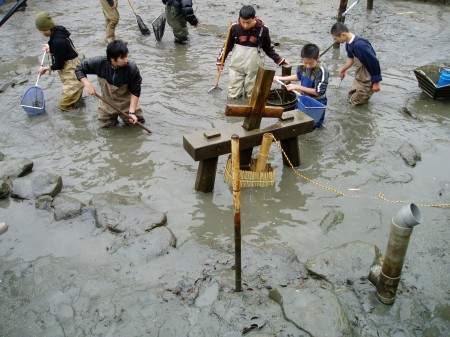conserve feel
Conserving biodiversity by using a traditional water purification method, “Dobi Nagashi” (draining ponds), widely practiced in Kochi’s satochi-satoyama
Incorporated NPO Nippon Baratanago (rosy bitterling) Takayasu Research Group
“Dobi Nagashi” (draining ponds) (Ikeboshi = draining ponds dry) is a traditional farming method widely practiced in Kochi’s satochi-satoyama for improving the water quality in ponds. Using this traditional method, this group prevents the mass development of green algae and invasive alien species to conserve the biodiversity of endemic species including the Nippon Baratanago (rosy bitterling).
There are approximately 400 ponds, large and small, in the Takayasu region of Yao City, Osaka Prefecture. These ponds are home to the Nippon Baratanago, an endangered species that belongs to the Cyprinidae (carp) family.
In 1998, this group began creating sanctuaries to preserve the biodiversity of ponds. Nippon Baratanago lay their eggs on freshwater bivalves known as Chinese pond mussels, that protect the eggs and larvae. The larvae of the Chinese pond mussels, on the other hand, attach themselves to the fins of demersal fishes such as freshwater goby from the Gobiidae family in order to grow.
In order to protect the Nippon Baratanago, it is key to maintain the ecosystem of ponds that protect biodiversity. In the Kochi region, the traditional water purification method, “Dobi Nagashi” (draining ponds) (Ikeboshi = draining ponds dry), was widely practiced. Dobi Nagashi involves draining the pond and pouring the sludge as well as the organic matter at the bottom of the pond into the irrigation channel. This sludge helps improve the quality of soil in the fields, and the fishes and clams gathered are used to create traditional dishes such as carassius wrapped in seaweed, as well as fish and beans. This all contributes to preserving biodiversity.
In 2005 and 2006, the group surveyed the effects of Dobi Nagashi and found that this method helped supply organic acids and metals as well as silicic acid. It also reined in the outbreak of blue-green algae, and encouraged the rapid growth of diatoms, which are food for Chinese pond mussel larvae. The following year, they discovered that the biodiversity of the pond, including endemic species such as the Nippon Baratanago, had been well maintained.
For 7 years since 2006, the ponds were drained each year using this method. This successfully prevented the outbreak of invasive alien species such as largemouth bass, bluegill, and the American bullfrog, and revitalized the ponds ecosystem for endemic fish and clam species. Currently, they are making efforts to condense, bring to the surface, and remove green algae, which tend to develop excessively in the now nutrient rich ponds. The group is also developing technology which detoxifies the toxic substance (MC) produced by green algae and transforms it into fertilizer with the help of bacteria.
更新日:2013.11.03 ※記事の内容は投稿当時のものです











